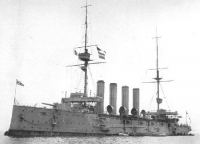A SUPERB & HISTORICALLY IMPORTANT
"U-9, SUBMARINE SINKING"
1914-15 Trio.
To:
152465.
Engine Room Articifer 1st Class.
HARRY WILKINS. R.N.
Killed-in-Action
HMS ABOUKIR
HMS ABOUKIR, HMS HOUGE & HMS CRESSY were all sunk by torpedoes fired by German Submarine U-9,
in under One Hour
on 22nd September 1914 .
"Perhaps the most famous & successful
Submarine Action of all time"
BACKGROUND
16 July 1914 the crew of U-9 reloaded her torpedo tubes while submerged, the first time any submarine had succeeded in doing so.
This development was to have far reaching implications for The Royal Navy in the early part of The Great War at sea.

 On August 1914, Kapitanleutant Otto Weddigen took command OF U-9 and
On August 1914, Kapitanleutant Otto Weddigen took command OF U-9 and
became world famous when on 22nd September 1914 he sank three 12,000 ton British cruisers in under One Hour and was responsible for the killing of 1,459 men in one single day.
After later sinking of HMS Hawke and other merchant ships he was awarded the Iron Cross and later the Pour Le Merite (The Blue Max)
************
THE ACTION
On 22 September, while patrolling the Broad Fourteens, a region of the southern North Sea, the U-9 under (Ltn. Otto Weddigen) found a squadron of three obsolescent British Cressy-class amoured cruisers (HMS Aboukir, HMS Hogue, and HMS Cressy) sardonically nicknamed the "Live Bait Squadron", which had been assigned to prevent German surface vessels from entering the eastern end of the English Channel. The Three vessels were steaming NNE at 10 knots without zigzagging. Although the patrols were supposed to maintain 12-13 knots and zigzag the old cruisers were unable to maintain that speed and the zigzagging order was widely ignored as there had been no submarines sighted in the area during the war. U-9 fired all six of her torpedoes, again reloading while submerged, and sank all three ships in less than an hour. 1,459 British sailors died. It was one of the most notable submarine actions of all time. Members of the Admiralty who had considered submarines "mere toys" no longer expressed that opinion after this event.
U-9 manoeuvred to attack and at about 06.25 am fired a single torpedo at HMS Aboukir, which stuck her on her port side. HMS Aboukir rapidly suffered heavy flooding and despite counter flooding developed a 20 degree list and lost engine power. It was soon clear that she was a lost cause and Captain Drummond ordered her to be abandoned, although only one boat had survived the attack so most crew had to jump into the sea. At first Drummond thought that HMS Aboukir had been mined and signalled the other two cruisers to close and assist but he soon realised that it was a torpedo attack and ordered the other two cruisers away, but too late as HMS Aboukir rolled over and sank, half an hour after being attacked. U-9 then fired two torpedoes at HMS Hogue that hit her amidships and rapidly flooded her engine room. Captain Nicholson of HMS Hogue had stopped the ship to lower boats to rescue the crew of HMS Aboukir, thinking that as he was the other side of HMS Aboukir from U-9 he would be safe. Unfortunately U-9 had manoeuvred around HMS Aboukir and attacked HMS Hogue from a range of only 300 yards.
U-9 subsequently sank HMS Cressy in a similar fashion.
Harry Wilkins
Was born on 11th September 1866 and at age 24 he joined the Royal Navy for an initial engagement of 12 years on 22nd January 1890. He was a qualified fitter upon entry. He served for 22 years until going to "Shore Pension" on 27th January 1912 but was recalled on 2nd August 1914 and went straight into service in HMS Aboukir.
His World War One service was to be but 51 days !
He attained the rank of ERA 1st Class and was serving at that rank until 16th May 1907 when he is seen being "DISRATED FOR MISCONDUCT" and reduced to ERA 4th Class.
He returned to ERA 1st Class on 16th May 1908 ! ..having served 12 months demotion for some *unknown offence.
(*Usually swearing at an officer who 'stuck his nose in' down in the engine room!)
He was the son of Cornelius and Sarah Ann Wilkins of Jeys Street, Chatham, and Husband of Cordelia Wilkins, of 173, Luton Road, Chatham, Kent. At age 48 Harry would have been one of the most experienced engineers serving in the ship.
HARRY IS REMEMBERED WITH HONOUR ON
"THE CHATHAM NAVAL MEMORIAL"
AN IMPORTANT GROUP TO A VERY FAMOUS U-BOAT ACTION.
MEDALS 'MINT' WITH ORIGINAL RIBBONS AND COPY SERVICE PAPERS.
£995


